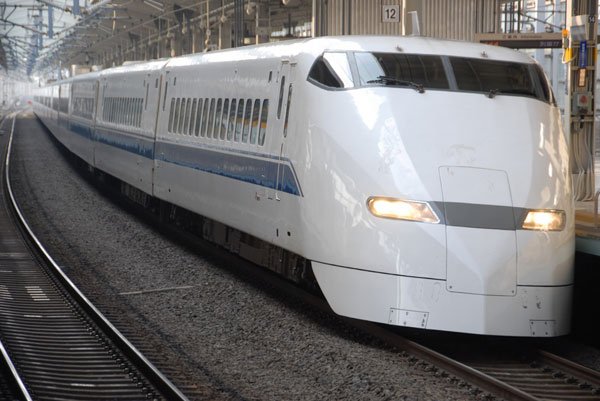As a tempest of opposition to the California High-Speed Rail
project brews in South County, City Council members and a vocal
group of local residents are becoming increasingly cynical about
the project’s benefits.
As a tempest of opposition to the California High-Speed Rail project brews in South County, City Council members and a vocal group of local residents are becoming increasingly cynical about the project’s benefits.
Bullet train representatives continue to meet with local residents and city officials – including during a special study session before Monday’s council meeting – but many council members say they are left with more questions than answers. Some wonder whether the project will benefit Gilroy at all.
“Just from a day-to-day quality of life aspect, everyone in Gilroy is going to wish it wasn’t there,” Councilwoman Cat Tucker said.
Tucker, a self-proclaimed public transportation advocate, said she initially supported a Gilroy bullet train station, but now wishes the rail line never came near Gilroy at all and instead took the other proposed route over the Altamont Pass instead.
She thinks a parking garage that would accommodate more than 6,000 vehicles would be “ugly” and questions how the High-Speed Rail Authority can conduct an environmental study on routes aligned with Union Pacific tracks when UP officials have publicly said they will not work with the rail authority.
Other city leaders are even more blunt after more than a year’s worth of quarterly updates from the rail authority
“Frankly, to a large extent, I just think this is a dog-and-pony show they’re putting on,” Councilman Perry Woodward said of a Monday night study session devoted to the bullet train.
Woodward wants to know where exactly the rail line will be placed and whether it will be placed in a 125-foot-wide trench – information that the rail authority has yet to provide.
Although the environmental impact report is not expected to be released until about a year from now, HSRA board member Rod Diridon, labeled the “father of modern transit service in Silicon Valley” on the HSRA website, anticipated that some information on noise and vibration impacts would be available by the end of August. In addition, the HSRA hopes to have 15 percent of the project plans determined by the end of the year, project manager Gary Kennerley said.
Still, rail officials say they cannot provide many of the details that council members and activists want because they aren’t available yet. The public workshops and study sessions allow them to gather some of the information that will be used to create a draft environmental impact report next year, Diridon said.
“I’m frustrated, too, that we don’t have all the information, but we can’t expect it until it’s been garnered,” he said. “We’re spending hundreds of millions of dollars up and down the state on the best consultants in the world.”
The $45-billion, 800-mile California High-Speed Rail system, expected to begin full operations in 2020, is slated to have routes from San Diego to Sacramento and to the Bay Area, transporting passengers at speeds of up to 220 mph. A 123-mile stretch from Merced to San Jose would run through Pacheco Pass and will likely include a station in Gilroy.
The rail authority released a draft document last month that outlined the possibility of aligning a rail line with the Monterey Street corridor, with U.S. Route 101 east of Gilroy or a combination of those two routes.
Each portion of the high-speed rail project deals with unique geographic challenges, Diridon said.
“The research has to be obtained by the best engineers we can hire, under the supervision of the best contract managers they can hire,” Diridon said. “It’s a time-consuming and expensive process.”
Details are not coming soon enough for several rural residents whose properties are in the line of a possible east Gilroy high-speed rail route.
“We’re not having a conversation,” said Yvonne Sheets-Saucedo, who owns property near a proposed eastern alignment for the tracks and has organized several Gilroy residents to question the project’s plans. “The high-speed rail authority shows up and they drone on and on. They don’t explain how either of those alignments will benefit Gilroy.”
Sheets-Saucedo continues to have a slew of questions for high-speed rail officials, such as whether the city of Gilroy is expected to pay for a parking garage for the project and what the process and timeline would be for forcibly acquiring people’s land for fair market value if necessary.
Like Tucker, Sheets-Saucedo also questioned how the HSRA could include the Monterey Street alignment for its environmental impact report when UP has denied use of its right of way.
Diridon said that the HSRA continues to be in conversation with UP and that the Federal Railroad Administration feels that a Monterey Street alignment should not be eliminated in the environmental review process.
“UP has a reputation for saying no and hell no on a possibility and then turning around for an agreement,” he said.
In addition, project officials have said in the past that whichever company develops a parking garage for the bullet train project would pay for it.
As for the subject of forcibly taking land, Diridon said the HSRA wants to avoid that scenario, if possible, and settle with landowners instead.
“Every time you go through eminent domain, you pay more money than you would otherwise,” he said.
Despite the push for more details, Diridon said it actually may be better to take the planning process at a slow pace and ensure that the process is conducted in a wise manner.
“There isn’t a crisis or a reason for a rush in this corridor,” he said. “We can take time to do the job that is absolutely desired by the public.”
Still, he said the HSRA ultimately would have to make tough decisions as it seeks to do what’s best for the majority of people.
Santa Clara County Supervisor Don Gage said he understood that people are not happy that their properties will be impacted.
At the same time, more structures will be threatened by the rail project the longer that time passes and more areas are developed, Gage said.
“Those people are certainly angry and upset, and I don’t blame them, but if you use that for a reason for not doing something, you wouldn’t build anything,” he said.














